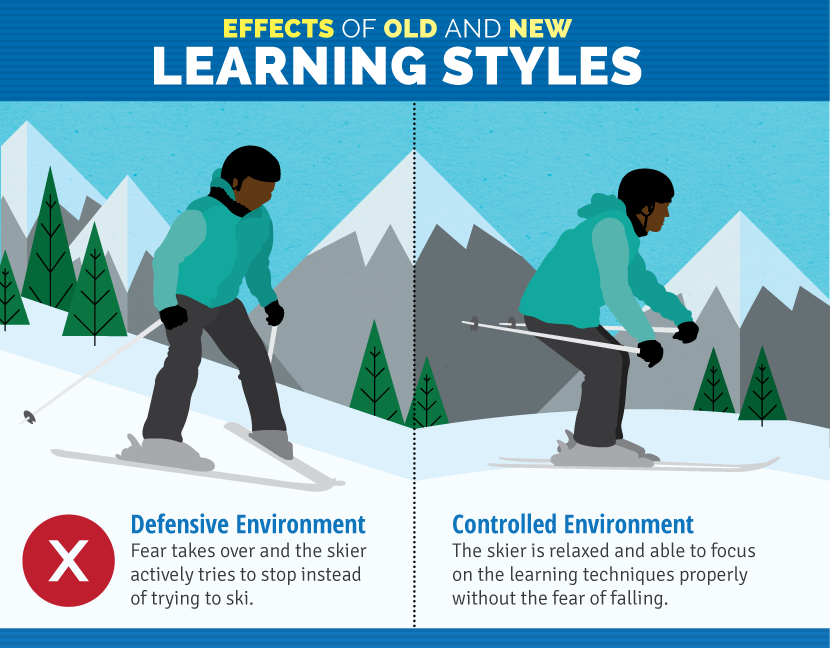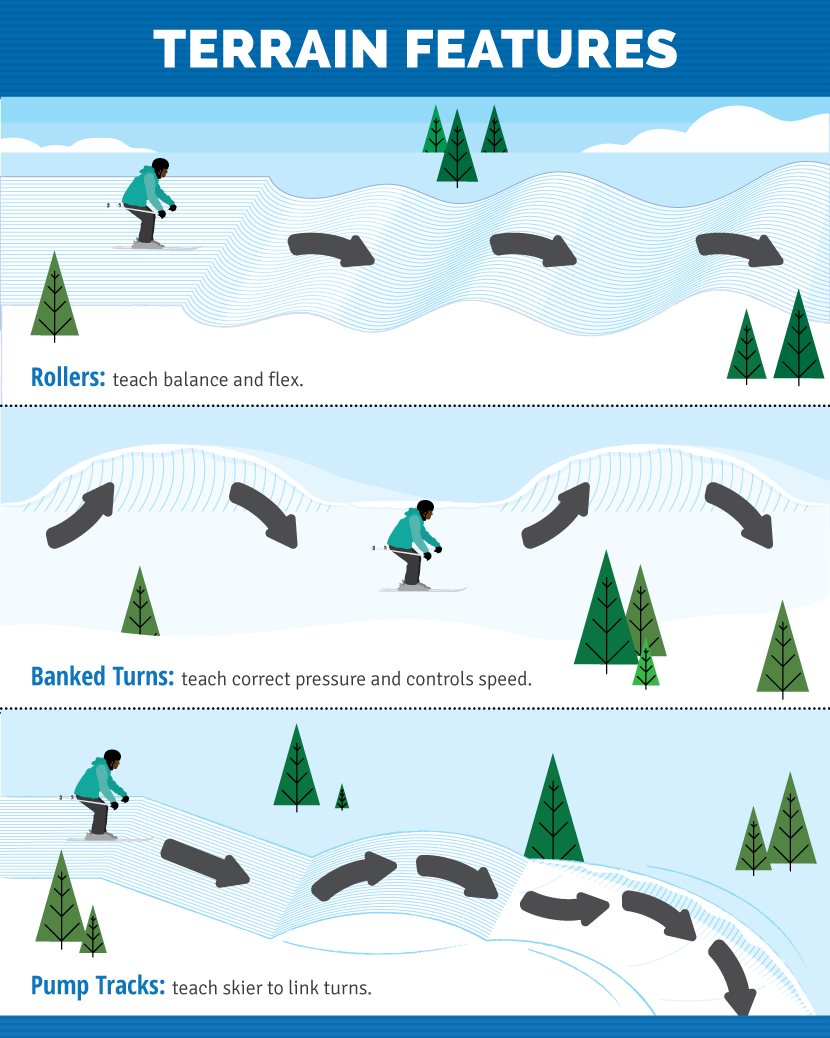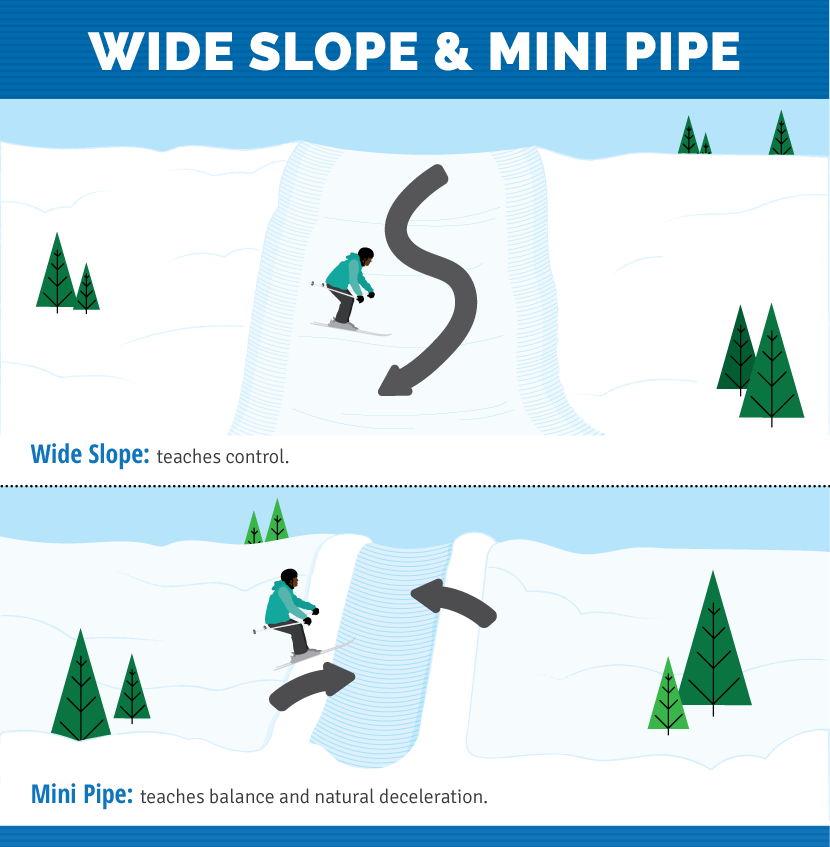Learn to Ski Fearlessly With Terrain-Based Learning
Back in the day, learning to ski was for the fearless. You pointed your tips downhill and hoped you’d listened when the instructor explained how to stop.
Now, a new teaching style called “terrain-based learning” makes the process much more fun and a lot less scary.
New learners – often called “never-evers,” since they’ve never ever been on skis – can learn to ski in a more relaxed, intuitive manner, using varied terrain features instead of steeper slopes.
No need to dread the “bunny hill” any longer, as snow elements found naturally on ski slopes are used in a controlled environment.
What is Terrain-Based Learning?
Terrain-based learning does away with the traditional defensive approach to traditional ski lessons.
Instead of starting on a slope, where never-evers are forced to immediately brace for a fall, new skiers are taught to respond to the feel of various terrain features in a primarily flat space. This allows for an entirely different, more responsive body stance.
Instead of learning how to slow and stop before learning any other skill, skiers are taught to shift balance, feel their edges, and respond to the snow while they are relaxed.
In other words, it’s all about responsive skiing instead of defensive skiing.

Terrain-based learning is not a ski style you can teach yourself, as it requires specially-designed terrain features made of snow, plus qualified instructors.
The good news: many ski schools are adopting terrain-based learning in place of traditional ski instruction methods, so skiers can expect to find the new approach at the resorts they already frequent, for no discernable price difference.
What’s Involved
terrain-based learning is all about the snow features, designed by ski school instructors and created by talented snow grooming teams. The main features of terrain-based learning include:
Rollers: Rollers are exactly what they sound like: gentle waves on the snow. The up and down movement required while sliding over rollers teaches skiers what flex feels like in their skis, and teaches balance as weight is shifted forward and backward.
Instructors can use the rolling movement to illustrate how skis respond better when weight is shifted forward, instead of back.
Banked turns: Banked turns sound intense, but actually assist never-evers in making their first cuts on the snow.
These gentle banks allow skiers to link their first turns, assisted by the snow bank to guide the skis. Without banks, the skier has to know how much pressure to put on the downhill ski, a skill that takes practice (and yes, a few falls).
The banks also help control the skier’s speed.
Pump tracks: Pump tracks combine rollers with banked turns, helping skiers to combine their newfound skills of balance and linking turns.
As never-evers navigate the track, they experience shifts in speed as they rise over bumps and slow naturally for turns.

Wide slopes: A wide slope with a very gradual decline gives skiers space to practice their skills with “room for error.”
Because these expansive areas are carefully groomed for ease of sliding, the skier can focus on finding the ski’s edge and linking turns without losing control.
A wide slope is the terrain element most often seen in ski school areas, and is used in both traditional and terrain-based learning.
Mini-pipes: Mini-pipes sound intimidating, but actually aid in controlling speed and allow never-evers to make full stops safely.
When skiers drop in, they learn balance and control. Because they stop naturally on the uphill bank, they can focus on gliding and, with practice, turning to traverse the pipe.

The Right Program For You
Terrain-based learning is replacing traditional ski programs at resorts across the U.S. and Canada; it takes the form of an official trademarked program, Terrain Based Learning™. You can find a list of resorts that feature terrain-based learning here.
Terrain-based learning programs vary, however, depending on the type of student they’ve been designed for. Some, like Northstar California’s Burton Snowboard Academy, are for snowboarders only.
Others, like Sierra-at-Tahoe’s Star Wars program, are designed to appeal to children by utilizing action figure structures or movie characters, such as Yoda statues and resort mascots.
Be sure to ask the following questions of any ski school before booking a lesson:
- Do you teach terrain-based learning?
- Is your program geared toward adults (or can it be adapted to adults)? Or, if you have kids: is it child-specific, and is the first rule to have fun? (It should be!)
- Is your program snowboard-specific?
- Are ski gear skills also taught(how to put on skis, how to fit boots)?
- Will any aspect of the program be taught on resort ski slopes, or is it all conducted in the terrain-based learning area?
The answers to these questions can tell you what to expect from any given program.
No matter where you go, arrive with a positive attitude and warm ski gear, and you’ll end your day with fewer falls, more smiles, and a better understanding of snow sports, thanks to terrain-based learning.
Embed the article on your site

